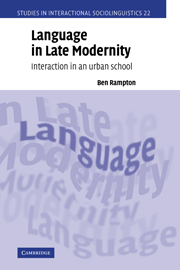Book contents
- Frontmatter
- Contents
- List of tables
- List of figures
- Acknowledgements
- Transcription conventions
- Part I Introduction
- Part II Urban classroom discourse
- Part III Performances of Deutsch
- Part IV The stylisation of social class
- 6 Language and class I: theoretical orientations
- 7 Language and class II: empirical preliminaries
- 8 Schooling, class and stylisation
- 9 Classed subjectivities in interaction
- Part V Methodological reflections
- References
- Index of names
- Subject index
7 - Language and class II: empirical preliminaries
Published online by Cambridge University Press: 22 September 2009
- Frontmatter
- Contents
- List of tables
- List of figures
- Acknowledgements
- Transcription conventions
- Part I Introduction
- Part II Urban classroom discourse
- Part III Performances of Deutsch
- Part IV The stylisation of social class
- 6 Language and class I: theoretical orientations
- 7 Language and class II: empirical preliminaries
- 8 Schooling, class and stylisation
- 9 Classed subjectivities in interaction
- Part V Methodological reflections
- References
- Index of names
- Subject index
Summary
As we saw in the last Chapter, the notion of ‘class’ can be used to embrace a huge range of cultural and material processes, involving social differentiation in “family background, main source of income, place of residence, cultural tastes … political affiliations etc” (Abercrombie and Warde et al. 2000:145–146; Chapter 6.1 above). My main concern is with ‘class formation and consciousness’, expressed in the stylised performance of posh and Cockney accents, but to get a better idea of what stylisation can and can't tell us about class consciousness, it is important to look at class through other ‘windows’ as well, and that is the purpose of the present chapter. More specifically, it addresses the first three questions identified in Chapter 6.4:
What kind of agents are the individuals and groups engaged in stylisation? What kinds of solidarity and opposition are they disposed towards? What struggles and negotiations over position do they engage in? Who's up, who's down, and what lines are they drawing, where, and in what kinds of activity?
What currency do established discourses about social class have among these youngsters? How do class discourses relate to discourses of ethnicity, race, gender and sexuality? Is it true that these young people have no access to “politicising scripts of class oppression”?
Are there signs of class hegemony? How far could we claim that class has been naturalised within these young people's common sense, influencing their “senses and assignments of energy, [their] shaping perceptions of [them]selves and [their] world”?
- Type
- Chapter
- Information
- Language in Late ModernityInteraction in an Urban School, pp. 239 - 268Publisher: Cambridge University PressPrint publication year: 2006



